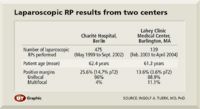Article
Functional outcomes of lap, open RP found similar
Author(s):
San Francisco--Despite its steep learning curve, laparoscopic radical prostatectomy is a safe, efficacious option that is feasible for routine use in specialized departments, results from a large series of laparoscopic radical prostatectomy procedures suggest.

The study analyzed outcomes for 475 laparoscopic radical prostatectomies performed at Charitéospital, Berlin, between May 1999 and September 2002, and 139 cases performed at the Lahey Clinic Medical Center, Burlington, MA, between February 2003 and April 2004. Five surgeons contributed to the German cohort, while the American cases represented a single-surgeon series.
Reported results included positive margin rates, along with potency and continence outcomes. Together, they showed laparoscopic radical prostatectomy was associated with early oncologic and functional results that are at least as good as open surgery.
"Laparoscopic radical prostatectomy is becoming a routine technique in an increasing number of specialized centers," said Ingolf A. Tuerk, MD, PhD, who was one of the surgeons operating at Charitéospital and the single surgeon at Lahey Clinic, where he is director of the Center for Minimally Invasive Urologic Surgery. "The available data show it has some significant advantages relative to open surgery in terms of reducing morbidity. And we might expect that, as follow-up continues, studies will also show that, with its superior exposure and better preservation of anatomical structures, laparoscopic radical prostatectomy has benefits for improving continence and potency rates as well."
Accuracy reflects experience
In both the German and American series, patients had an average age of about 60 years (range, 28-75 years). However, comparison of the disease-related features of the two groups showed considerable regional differences, with the German men typically presenting with more advanced tumors.
At Charité mean PSA was 10.2 ng/mL, and the majority of men were clinical stage T2a/b (58%), while about 40% had stage T1c disease, and a small minority (3%) were stage T1a/b. In contrast, more than three-fourths of men in the American series were stage T1c, only one man was clinical stage T2c, and the rest (19%) had stage T2a cancer. Mean PSA for the American men was 6.4 ng/mL.
The earlier diagnosis of prostate cancer in the United States compared with Germany was also reflected by differences in positive margin rates between the two centers-13.6% at the Lahey Clinic versus 25.5% at Charité ospital. Nevertheless, when the analysis was restricted to the subgroup of men with pathologically organ-confined disease, there was still a significantly lower positive margin rate in the U.S. and German series (3.6% vs. 14.7%, respectively). Dr. Tuerk attributed that finding to differences in surgeon experience.
"There is a difficult learning curve for laparoscopic radical prostatectomy, and the surgical accuracy of the procedure depends on the surgeon's experience," he said. "All of the procedures at the Lahey Clinic were performed by a single, very experienced surgeon, while the cases from Charité ospital reflect the learning curve of five surgeons."
Dr. Tuerk added that results from a published prospective study of 100 consecutive laparoscopic radical prostatectomies performed at Charité ospital also showed a strong trend for a significant difference in positive margin rates between junior and senior surgeons-34% versus 14%, respectively (Eur Urol 2003; 43:622-6).
"Those data further confirm that laparoscopic radical prostatectomy is a complex and challenging procedure, but also provide proof that it can be taught in the proper setting without compromising patient outcomes," he said.
Newsletter
Stay current with the latest urology news and practice-changing insights — sign up now for the essential updates every urologist needs.















